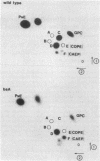Abstract
A behavioral mutant of Paramecium tetraurelia (baA) has been isolated that has an abnormal response when placed in solutions containing Ba2+. This mutant is shown here to have a dramatic alteration of the sphingolipid and phosphonolipid composition of its ciliary membrane. This biochemical defect is present in independently isolated alleles at baA locus and segregates in crosses with the behavioral phenotype. Electrophysiologically, the mutation reduces significantly conductance of both voltage-sensitive Ca2+ channels and voltage-sensitive K+ channels. When the mutant is grown in sterol-supplemented medium, its behavior, electrophysiological properties, and lipid composition are hardly distinguishable from wild type grown under similar conditions. This mutant then, provides strong evidence that membrane lipids significantly influence the function of the membrane molecules responsible for the generation of action potentials.
Full text
PDF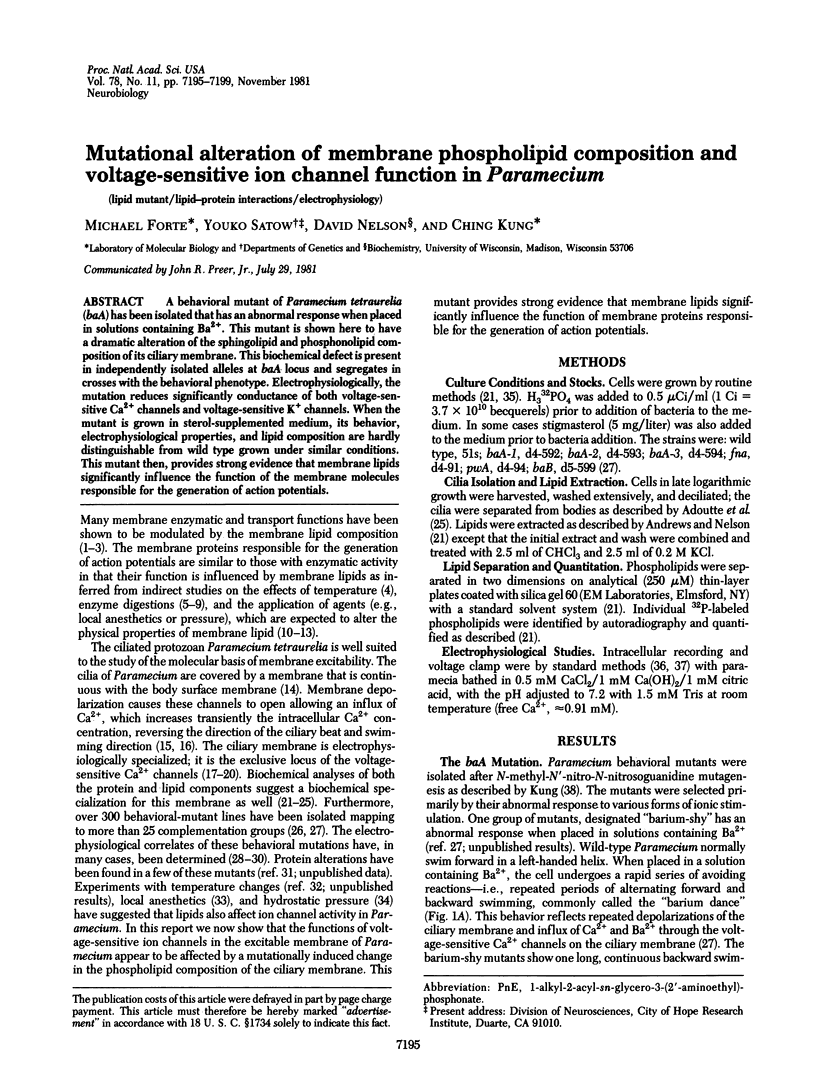
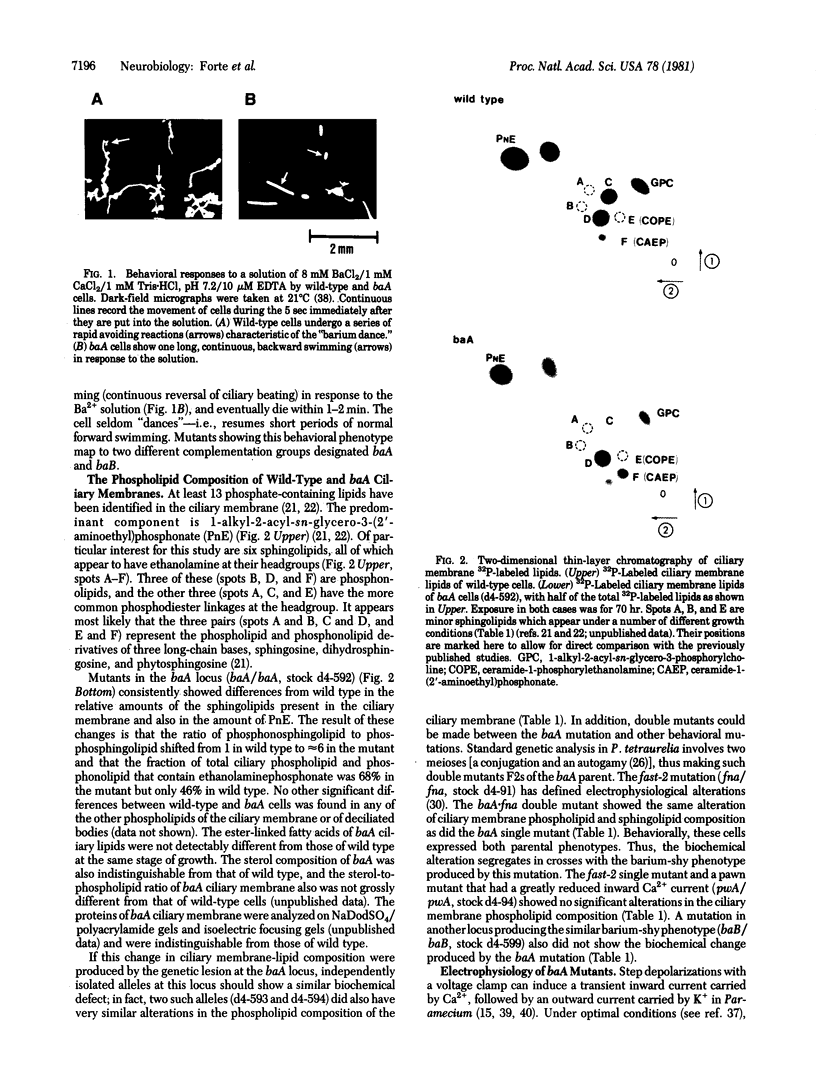
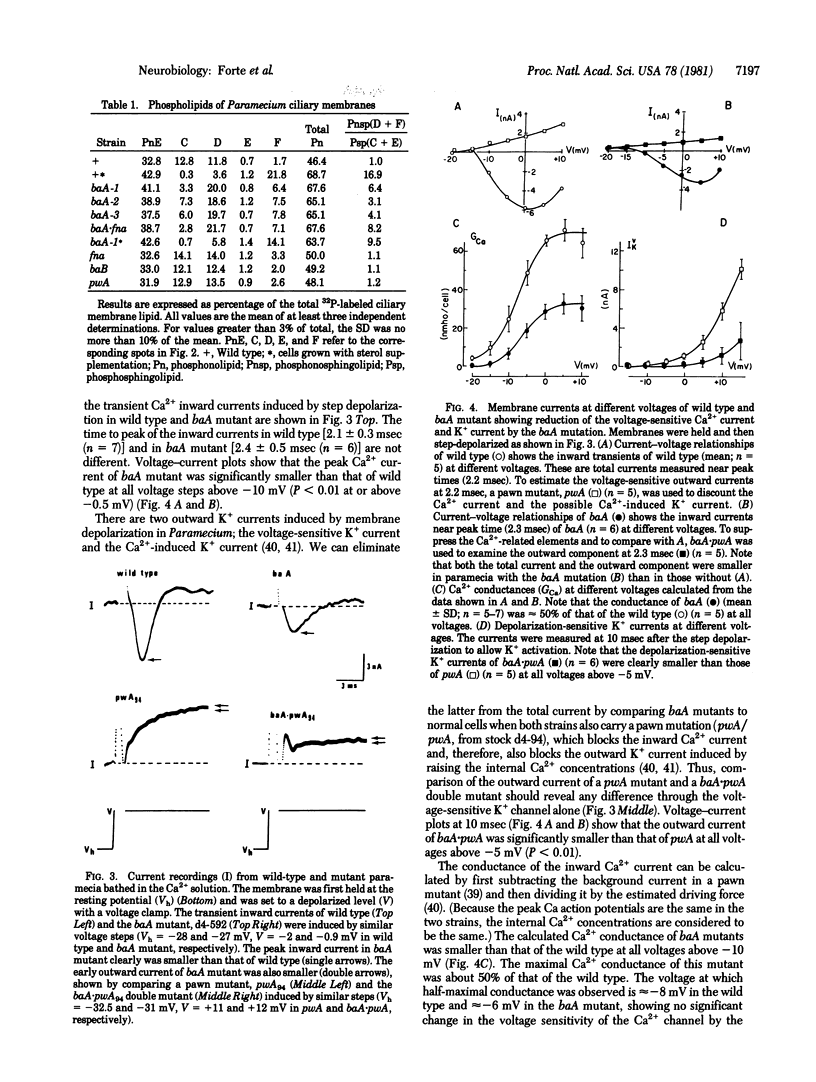

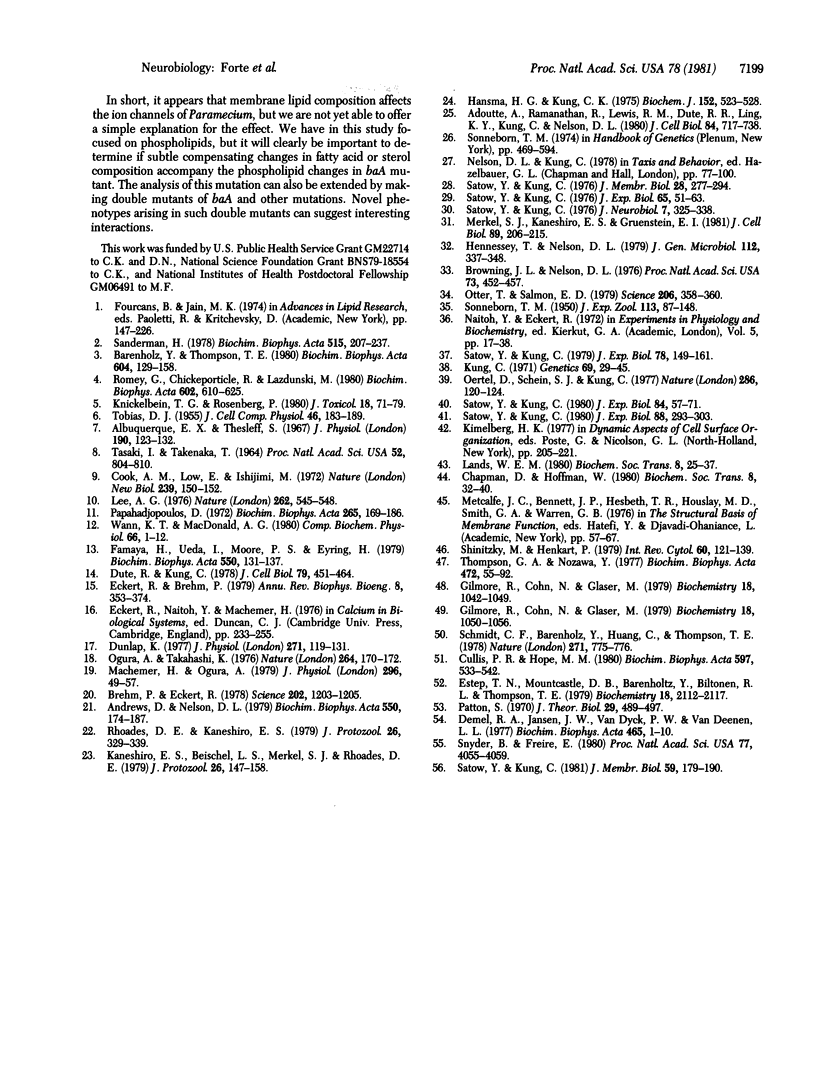
Images in this article
Selected References
These references are in PubMed. This may not be the complete list of references from this article.
- Adoutte A., Ramanathan R., Lewis R. M., Dute R. R., Ling K. Y., Kung C., Nelson D. L. Biochemical studies of the excitable membrane of Paramecium tetraurelia. III. Proteins of cilia and ciliary membranes. J Cell Biol. 1980 Mar;84(3):717–738. doi: 10.1083/jcb.84.3.717. [DOI] [PMC free article] [PubMed] [Google Scholar]
- Albuquerque E. X., Thesleff S. Influence of phospholipase C on some electrical properties of the skeletal muscle membrane. J Physiol. 1967 May;190(1):123–137. doi: 10.1113/jphysiol.1967.sp008197. [DOI] [PMC free article] [PubMed] [Google Scholar]
- Andrews D., Nelson D. L. Biochemical studies of the excitable membrane of Paramecium tetraurelia. II. Phospholipids of ciliary and other membranes. Biochim Biophys Acta. 1979 Jan 19;550(2):174–187. doi: 10.1016/0005-2736(79)90205-0. [DOI] [PubMed] [Google Scholar]
- Barenholz Y., Thompson T. E. Sphingomyelins in bilayers and biological membranes. Biochim Biophys Acta. 1980 Sep 30;604(2):129–158. doi: 10.1016/0005-2736(80)90572-6. [DOI] [PubMed] [Google Scholar]
- Brehm P., Eckert R. Calcium entry leads to inactivation of calcium channel in Paramecium. Science. 1978 Dec 15;202(4373):1203–1206. doi: 10.1126/science.103199. [DOI] [PubMed] [Google Scholar]
- Browning J. L., Nelson D. L. Amphipathic amines affect membrane excitability in paramecium: role for bilayer couple. Proc Natl Acad Sci U S A. 1976 Feb;73(2):452–456. doi: 10.1073/pnas.73.2.452. [DOI] [PMC free article] [PubMed] [Google Scholar]
- Chapman D., Hoffmann W. Enzyme function and membrane lipids. Biochem Soc Trans. 1980 Feb;8(1):32–34. doi: 10.1042/bst0080032. [DOI] [PubMed] [Google Scholar]
- Cook A. M., Low E., Ishijimi M. Effect of phosphatidyl serine decarboxylase on neural excitation. Nat New Biol. 1972 Oct 4;239(92):150–151. doi: 10.1038/newbio239150a0. [DOI] [PubMed] [Google Scholar]
- Cullis P. R., Hope M. J. The bilayer stabilizing role of sphingomyelin in the presence of cholesterol: a 31P NMR study. Biochim Biophys Acta. 1980 Apr 24;597(3):533–542. doi: 10.1016/0005-2736(80)90225-4. [DOI] [PubMed] [Google Scholar]
- Demel R. A., Jansen J. W., van Dijck P. W., van Deenen L. L. The preferential interaction of cholesterol with different classes of phospholipids. Biochim Biophys Acta. 1977 Feb 14;465(1):1–10. doi: 10.1016/0005-2736(77)90350-9. [DOI] [PubMed] [Google Scholar]
- Dute R., Kung C. Ultrastructure of the proximal region of somatic cilia in Paramecium tetraurelia. J Cell Biol. 1978 Aug;78(2):451–464. doi: 10.1083/jcb.78.2.451. [DOI] [PMC free article] [PubMed] [Google Scholar]
- Eckert R., Brehm P. Ionic mechanisms of excitation in Paramecium. Annu Rev Biophys Bioeng. 1979;8:353–383. doi: 10.1146/annurev.bb.08.060179.002033. [DOI] [PubMed] [Google Scholar]
- Estep T. N., Mountcastle D. B., Barenholz Y., Biltonen R. L., Thompson T. E. Thermal behavior of synthetic sphingomyelin-cholesterol dispersions. Biochemistry. 1979 May 15;18(10):2112–2117. doi: 10.1021/bi00577a042. [DOI] [PubMed] [Google Scholar]
- Gilmore R., Cohn N., Glaser M. Fluidity of LM cell membranes with modified lipid compositions as determined with 1,6-diphenyl-1,3,5-hexatriene. Biochemistry. 1979 Mar 20;18(6):1042–1049. doi: 10.1021/bi00573a017. [DOI] [PubMed] [Google Scholar]
- Gilmore R., Cohn N., Glaser M. Rotational relaxation times of 1,6-diphenyl-1,3,5-hexatriene in phospholipids isolated from LM cell membranes. Effects of phospholipid polar head-group and fatty acid composition. Biochemistry. 1979 Mar 20;18(6):1050–1056. doi: 10.1021/bi00573a018. [DOI] [PubMed] [Google Scholar]
- Hansma H. G., Kung C. Studies of the cell surface of Paramecium. Ciliary membrane proteins and immobilization antigens. Biochem J. 1975 Dec;152(3):523–528. doi: 10.1042/bj1520523. [DOI] [PMC free article] [PubMed] [Google Scholar]
- Kamaya H., Ueda I., Moore P. S., Eyring H. Antagonism between high pressure and anesthetics in the thermal phase-transition of dipalmitoyl phosphatidylcholine bilayer. Biochim Biophys Acta. 1979 Jan 5;550(1):131–137. doi: 10.1016/0005-2736(79)90121-4. [DOI] [PubMed] [Google Scholar]
- Knickelbein R. G., Rosenberg P. Differential phospholipid hydrolysis by phospholipase C in sarcolemma of muscles with calcium or sodium generated action potentials. Toxicon. 1980;18(1):71–86. doi: 10.1016/0041-0101(80)90033-1. [DOI] [PubMed] [Google Scholar]
- Kung C. Genic mutants with altered system of excitation in Paramecium aurelia. II. Mutagenesis, screening and genetic analysis of the mutants. Genetics. 1971 Sep;69(1):29–45. doi: 10.1093/genetics/69.1.29. [DOI] [PMC free article] [PubMed] [Google Scholar]
- Lands W. E. Dialogue between membranes and their lipid-metabolizing enzymes. Biochem Soc Trans. 1980 Feb;8(1):25–27. doi: 10.1042/bst0080025. [DOI] [PubMed] [Google Scholar]
- Lee A. G. Model for action of local anaesthetics. Nature. 1976 Aug 12;262(5569):545–548. doi: 10.1038/262545a0. [DOI] [PubMed] [Google Scholar]
- Machemer H., Ogura A. Ionic conductances of membranes in ciliated and deciliated Paramecium. J Physiol. 1979 Nov;296:49–60. doi: 10.1113/jphysiol.1979.sp012990. [DOI] [PMC free article] [PubMed] [Google Scholar]
- Merkel S. J., Kaneshiro E. S., Gruenstein E. I. Characterization of the cilia and ciliary membrane proteins of wild-type Paramecium tetraurelia and a pawn mutant. J Cell Biol. 1981 May;89(2):206–215. doi: 10.1083/jcb.89.2.206. [DOI] [PMC free article] [PubMed] [Google Scholar]
- Oertel D., Schein S. J., Kung C. Separation of membrane currents using a Paramecium mutant. Nature. 1977 Jul 14;268(5616):120–124. doi: 10.1038/268120a0. [DOI] [PubMed] [Google Scholar]
- Ogura A., Takahashi K. Artificial deciliation causes loss of calcium-dependent responses in Paramecium. Nature. 1976 Nov 11;264(5582):170–172. doi: 10.1038/264170a0. [DOI] [PubMed] [Google Scholar]
- Otter T., Salmon E. D. Hydrostatic pressure reversibly blocks membrane control of ciliary motility in Paramecium. Science. 1979 Oct 19;206(4416):358–361. doi: 10.1126/science.482945. [DOI] [PubMed] [Google Scholar]
- Papahadjopoulos D. Studies on the mechanism of action of local anesthetics with phospholipid model membranes. Biochim Biophys Acta. 1972 Apr 18;265(2):169–186. doi: 10.1016/0304-4157(72)90001-9. [DOI] [PubMed] [Google Scholar]
- Patton S. Correlative relationship of cholesterol and sphingomyelin in cell membranes. J Theor Biol. 1970 Dec;29(3):489–491. doi: 10.1016/0022-5193(70)90111-6. [DOI] [PubMed] [Google Scholar]
- Rhoads D. E., Kaneshiro E. S. Characterizations of phospholipids from Paramecium tetraurelia cells and cilia. J Protozool. 1979 May;26(2):329–338. doi: 10.1111/j.1550-7408.1979.tb02790.x. [DOI] [PubMed] [Google Scholar]
- Romey G., Chicheportiche R., Lazdunski M. Transition temperatures of the electrical activity of ion channels in the nerve membrane. Biochim Biophys Acta. 1980 Nov 18;602(3):610–620. doi: 10.1016/0005-2736(80)90339-9. [DOI] [PubMed] [Google Scholar]
- Satow Y., Kung C. A 'TEA+-insensitive' mutant with increased potassium conductance in Paramecium aurelia. J Exp Biol. 1976 Aug;65(1):51–63. doi: 10.1242/jeb.65.1.51. [DOI] [PubMed] [Google Scholar]
- Satow Y., Kung C. A mutant of Paramecium with increased relative resting potassium permeability. J Neurobiol. 1976 Jul;7(4):325–338. doi: 10.1002/neu.480070405. [DOI] [PubMed] [Google Scholar]
- Satow Y., Kung C. Ca-induced K+-outward current in Paramecium tetraurelia. J Exp Biol. 1980 Oct;88:293–303. doi: 10.1242/jeb.88.1.293. [DOI] [PubMed] [Google Scholar]
- Satow Y., Kung C. Membrane currents of pawn mutants of the pwA group in Paramecium tetraurelia. J Exp Biol. 1980 Feb;84:57–71. doi: 10.1242/jeb.84.1.57. [DOI] [PubMed] [Google Scholar]
- Satow Y., Kung C. Mutants with reduced Ca activation in Paramecium aurelia. J Membr Biol. 1976 Aug 26;28(2-3):277–294. doi: 10.1007/BF01869701. [DOI] [PubMed] [Google Scholar]
- Satow Y., Kung C. Possible reduction of surface charge by a mutation in Paramecium tetraurelia. J Membr Biol. 1981 Apr 30;59(3):179–190. doi: 10.1007/BF01875424. [DOI] [PubMed] [Google Scholar]
- Schmidt C. F., Barenholz Y., Huang C., Thompson T. E. Monolayer coupling in sphingomyelin bilayer systems. Nature. 1978 Feb 23;271(5647):775–777. doi: 10.1038/271775a0. [DOI] [PubMed] [Google Scholar]
- Shinitzky M., Henkart P. Fluidity of cell membranes--current concepts and trends. Int Rev Cytol. 1979;60:121–147. [PubMed] [Google Scholar]
- Snyder B., Freire E. Compositional domain structure in phosphatidylcholine--cholesterol and sphingomyelin--cholesterol bilayers. Proc Natl Acad Sci U S A. 1980 Jul;77(7):4055–4059. doi: 10.1073/pnas.77.7.4055. [DOI] [PMC free article] [PubMed] [Google Scholar]
- TASAKI I., TAKENAKA T. EFFECTS OF VARIOUS POTASSIUM SALTS AND PROTEASES UPON EXCITABILITY OF INTRACELLULARLY PERFUSED SQUID GIANT AXONS. Proc Natl Acad Sci U S A. 1964 Sep;52:804–810. doi: 10.1073/pnas.52.3.804. [DOI] [PMC free article] [PubMed] [Google Scholar]
- TOBIAS J. M. Effects of phospholipases, collagenase and chymotrypsin on impulse conduction and resting potential in the lobster axon with parallel experiments on frog muscle. J Cell Physiol. 1955 Oct;46(2):183–207. doi: 10.1002/jcp.1030460203. [DOI] [PubMed] [Google Scholar]
- Thompson G. A., Jr, Nozawa Y. Tetrahymena: a system for studying dynamic membrane alterations within the eukaryotic cell. Biochim Biophys Acta. 1977 May 31;472(1):55–92. doi: 10.1016/0304-4157(77)90014-4. [DOI] [PubMed] [Google Scholar]



